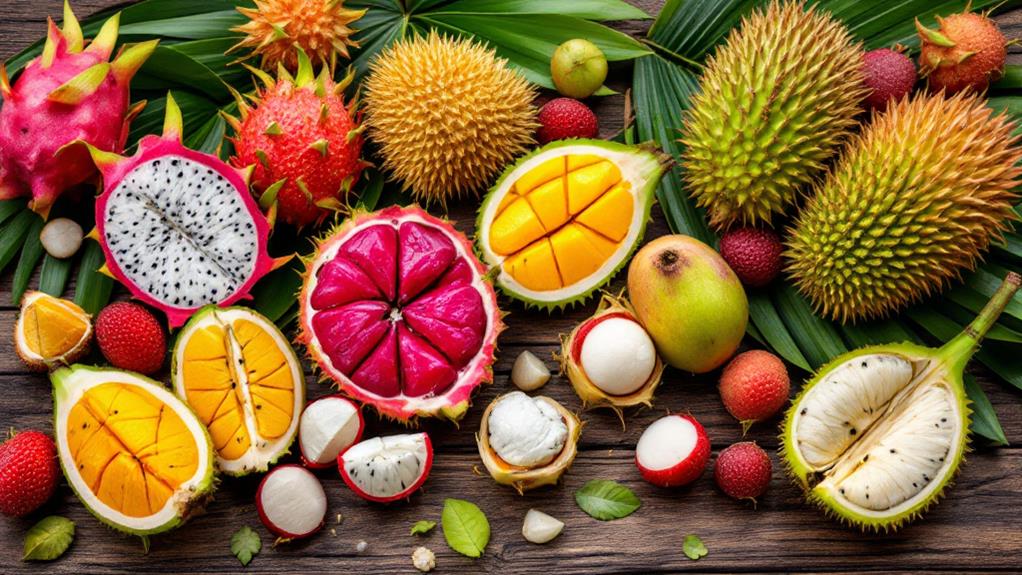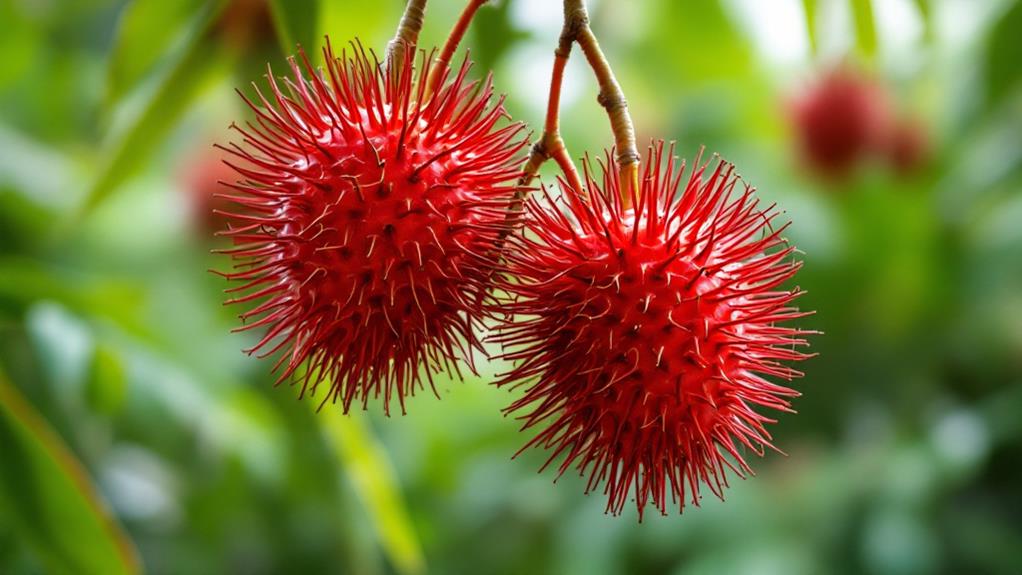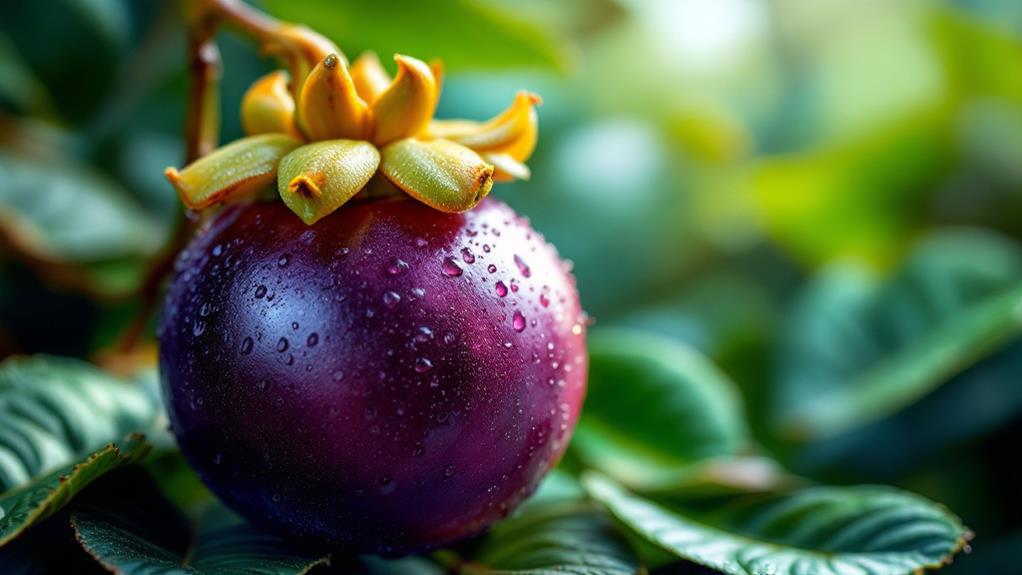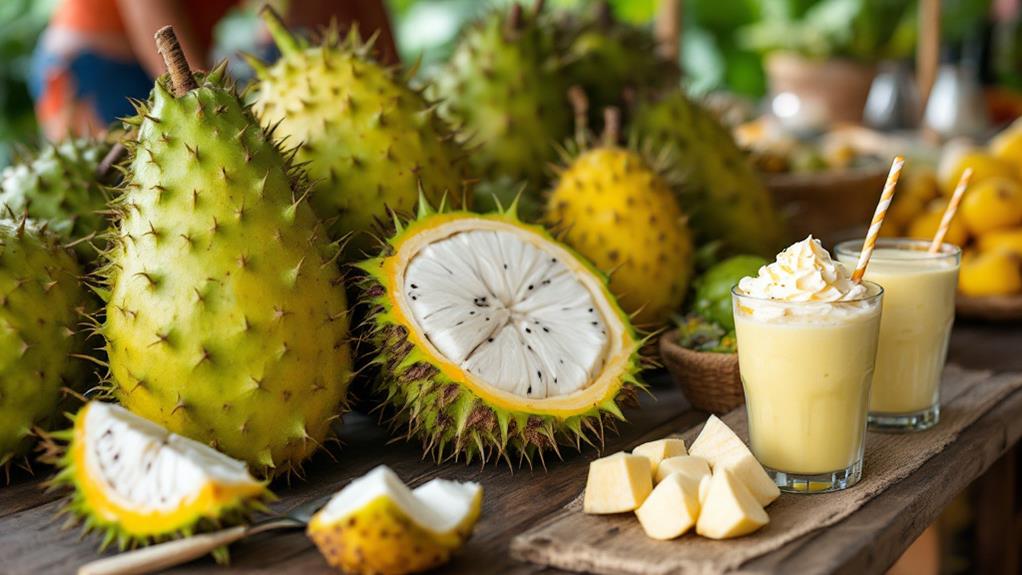Amazing Exotic Fruits: Unusual Fruits From Around the World

Undertake a global flavor exploration with exotic fruits that'll captivate your taste buds. You'll encounter the infamous durian, known for its pungent aroma and creamy flesh, and the visually striking dragon fruit with its vibrant exterior. Don't miss the hairy rambutan or the delicate lychee, both offering unique textures and flavors. The mangosteen's purple crown hides a sweet-tangy interior, while jackfruit serves as a surprising meat alternative. Soursop delivers creamy goodness, and passion fruit packs a tangy punch. These unusual fruits offer a world of new culinary experiences waiting to be discovered.
Durian: King of Fruits
Known as the "King of Fruits" throughout Southeast Asia, durian is a polarizing delicacy that sparks intense debate among food enthusiasts. You'll recognize this large, oval-shaped fruit by its distinctive spiny exterior, which protects the creamy flesh inside. When you crack open a durian, you'll be greeted by a pungent aroma that's often described as a mix of rotten onions, turpentine, and raw sewage.
Despite its notorious smell, durian's custard-like flesh offers a complex flavor profile that many find irresistible. You'll experience a rich, sweet taste with hints of almond, caramel, and vanilla. The texture is smooth and creamy, similar to a ripe avocado.
You'll find durian in various forms, from fresh fruit to flavored candies and ice cream. It's packed with nutrients, including vitamin C, potassium, and healthy fats. However, be aware that some countries and establishments ban durian due to its strong odor. If you're feeling adventurous, give this controversial fruit a try – you might just become a devoted fan.
Dragon Fruit's Fiery Appeal
A visual spectacle among exotic fruits, dragon fruit enthralls with its lively pink or golden exterior adorned with green scales. Its mysterious allure doesn't stop at the surface; when you slice it open, you'll uncover a white or radiant red flesh speckled with tiny black seeds. This fruit's fiery appeal lies not only in its striking appearance but also in its subtle, invigorating taste.
You'll find dragon fruit packed with nutrients and antioxidants, making it a healthy addition to your diet. Its mild flavor, often compared to a blend of kiwi and pear, lends itself well to various culinary applications. You can enjoy it fresh, blend it into smoothies, or use it as a colorful garnish for desserts and salads.
It's also known as pitaya or strawberry pear. The fruit grows on a cactus species native to Central and South America. Dragon fruit flowers bloom for just one night before wilting.
Despite its fierce name and vibrant colors, dragon fruit offers a surprisingly delicate taste experience that's sure to captivate your senses.
Rambutan's Hairy Exterior

While dragon fruit enthralls with its lively exterior, rambutan intrigues with its peculiar hairy appearance. You'll find this Southeast Asian fruit captivating with its textured exterior, covered in soft, flexible spines. These "hairs" aren't prickly but rather give the fruit a unique, almost alien-like quality.
Rambutans come in vibrant colors, typically sporting a bright red or yellow outer layer. When you peel back this hairy shell, you'll uncover a translucent, grape-like flesh inside. The contrast between the wild exterior and the smooth, sweet interior is part of what makes rambutans so fascinating.
You might be surprised to learn that these hairy protrusions serve a purpose. They help protect the fruit from pests and excessive sunlight, ensuring the delicate flesh inside remains perfect for consumption. As you hold a rambutan, you'll notice how the spines yield easily to your touch, inviting you to investigate further. This exotic fruit's distinctive appearance not only catches your eye but also provides a tactile experience unlike any other common fruit you've encountered.
Lychee's Delicate Sweetness
Moving from the hairy rambutan, you'll uncover lychee presents a more polished, sophisticated exterior. This small, round fruit boasts a thin, bumpy skin that's easily peeled away to reveal a translucent white flesh. When you bite into a lychee, you'll experience its delicate texture, which is both juicy and firm.
Lychee's aromatic flavor is a harmonious blend of sweet and tart notes, often compared to a mix of grape and rose water. It's an invigorating treat that's perfect for hot summer days. You'll find lychees are versatile in culinary applications:
- Add them to fruit salads for a burst of exotic flavor
- Blend them into smoothies or cocktails for a unique twist
- Use them as a topping for desserts like ice cream or sorbet
Native to southern China, lychees have gained popularity worldwide. They're rich in vitamin C and antioxidants, making them a healthy snack option. When selecting lychees, look for fruits with bright red or pinkish-brown skin. Avoid those with dark spots or a dull appearance. You can enjoy lychees fresh, canned, or dried, each offering a slightly different taste experience.
Mangosteen's Purple Crown

From the delicate sweetness of lychee, we turn our attention to the regal mangosteen. You'll be entranced by its striking appearance, featuring a deep purple rind crowned with a distinctive green calyx. This tropical fruit's vibrant color and unique shape make it stand out among its exotic counterparts.
When you crack open a mangosteen, you'll uncover segments of snow-white flesh that contrast beautifully with its dark exterior. The taste is often described as a perfect balance of sweet and tangy, with notes of peach, strawberry, and citrus. It's no wonder the mangosteen has earned the moniker "Queen of Fruits."
Native to Southeast Asia, mangosteens thrive in hot, humid climates. You'll find them growing in countries like Thailand, Malaysia, and Indonesia. The fruit's thick rind protects its delicate interior, making it challenging to export fresh. That's why you're more likely to encounter mangosteens in their native regions or as frozen or canned products elsewhere.
When selecting mangosteens, look for firm fruits with unblemished rinds. The deeper the purple, the riper the fruit.
Jackfruit: Nature's Meat Alternative
The jackfruit stands out as one of nature's most versatile fruits. You'll be amazed by its size, often weighing up to 80 pounds, and its unique texture that resembles pulled pork when cooked. This tropical fruit has gained popularity as a meat alternative due to its culinary versatility and impressive nutritional profile.
When you try jackfruit, you'll immerse yourself in its mild flavor that easily absorbs seasonings, making it perfect for various dishes. It's rich in fiber, potassium, and vitamin C, while being low in calories. You can use it in both savory and sweet recipes, from tacos and curries to desserts and smoothies.
The jackfruit offers a delicious and nutritious option. You'll find it fresh in some markets or conveniently packaged in cans, ready to transform your next meal into an exotic culinary exploration.
- It's an excellent source of plant-based protein
- It helps reduce your carbon footprint compared to meat consumption
- It's naturally gluten-free and suitable for many dietary restrictions
Whether you're a vegan, vegetarian, or simply looking to diversify your meals, the jackfruit presents a rewarding and versatile choice.
Soursop's Creamy Goodness

Many tropical fruit enthusiasts consider soursop a hidden gem among exotic delicacies. You'll find this spiky green fruit primarily in the Caribbean, Central America, and parts of Southeast Asia. When you cut open a soursop, you'll uncover its white, fibrous flesh with a creamy texture that's reminiscent of custard.
The unique flavor of soursop is often described as a blend of strawberry and pineapple with subtle notes of coconut and banana. It's both sweet and tart, making it an invigorating treat in hot climates. You can enjoy soursop fresh, but it's also popular in smoothies, ice creams, and juices.
Beyond its taste, soursop is packed with nutrients. It's rich in vitamin C, fiber, and antioxidants. Some cultures use it in traditional medicine, though scientific evidence for its health benefits is limited. When selecting a soursop, choose one that's slightly soft to the touch and has a lively green color. Don't be put off by its intimidating appearance – the delicious, creamy goodness inside is well worth the effort of cutting through its tough exterior.
Passion Fruit's Tangy Burst
Passion fruit packs a powerful punch of flavor in a small, unassuming package. You'll be amazed by the intense aroma and taste that bursts forth when you crack open one of these egg-shaped fruits. The pulp's vibrant color, ranging from golden yellow to deep purple, is a feast for the eyes.
When you scoop out the juicy seeds and pulp, you'll experience a perfect balance of sweetness and tart acidity. It's this unique combination that makes passion fruit a favorite among chefs and home cooks alike. You can enjoy it raw, or use it to heighten a variety of dishes:
- Blend it into smoothies for a tropical twist
- Drizzle it over yogurt or ice cream for a tangy dessert
- Use it as a glaze for meats or in salad dressings
Don't let its wrinkled exterior fool you; the more wrinkled the skin, the riper and sweeter the fruit. You'll find passion fruit adds a sophisticated touch to both sweet and savory recipes. Its versatility and intense flavor profile make it a must-try for any adventurous food lover.



